engine overheat TOYOTA AVENSIS 2015 Owners Manual
[x] Cancel search | Manufacturer: TOYOTA, Model Year: 2015, Model line: AVENSIS, Model: TOYOTA AVENSIS 2015Pages: 648, PDF Size: 39.64 MB
Page 6 of 648
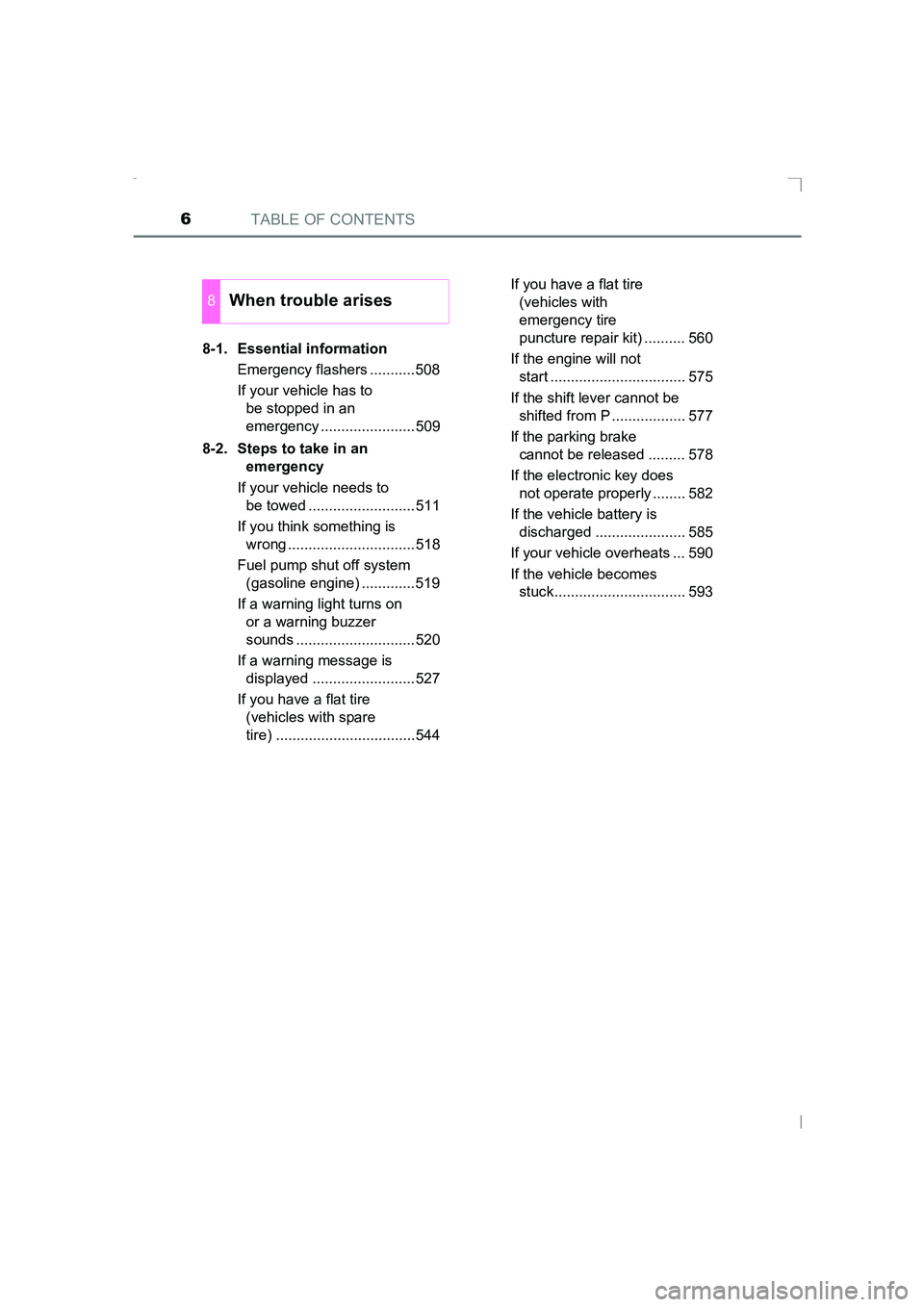
TABLE OF CONTENTS6
AVENSIS_OM_OM20C20E_(EE)8-1. Essential information
Emergency flashers ...........508
If your vehicle has to be stopped in an
emergency .......................509
8-2. Steps to take in an emergency
If your vehicle needs to be towed ..........................511
If you think something is wrong ...............................518
Fuel pump shut off system (gasoline engine) .............519
If a warning light turns on or a warning buzzer
sounds .............................520
If a warning message is displayed .........................527
If you have a flat tire (vehicles with spare
tire) ..................................544 If you have a flat tire
(vehicles with
emergency tire
puncture repair kit) .......... 560
If the engine will not start ................................. 575
If the shift lever cannot be shifted from P .................. 577
If the parking brake cannot be released ......... 578
If the electronic key does not operate properly ........ 582
If the vehicle battery is discharged ...................... 585
If your vehicle overheats ... 590
If the vehicle becomes stuck................................ 593
8When trouble arises
AVENSIS_OM_OM20C20E_(EE).book Page 6 Thursday, January 29, 20 15 1:47 PM
Page 13 of 648
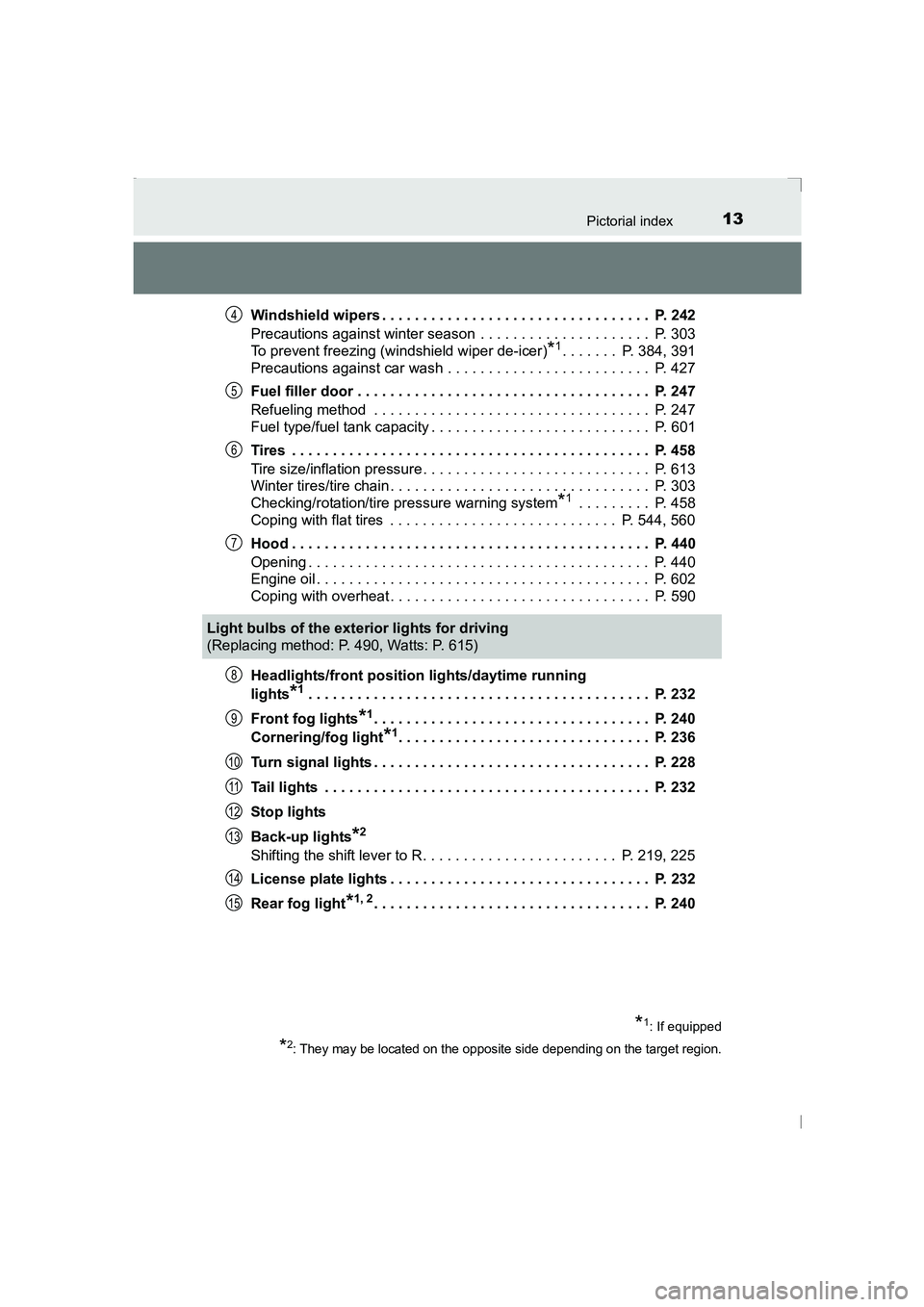
13Pictorial index
AVENSIS_OM_OM20C20E_(EE)Windshield wipers . . . . . . . . . . . . . . . . . . . . . . . . . . . . . . . . . P. 242
Precautions against winter season . . . . . . . . . . . . . . . . . . . . . P. 303
To prevent freezing (windshield wiper de-icer)
*1. . . . . . . P. 384, 391
Precautions against car wash . . . . . . . . . . . . . . . . . . . . . . . . . P. 427
Fuel filler door . . . . . . . . . . . . . . . . . . . . . . . . . . . . . . . . . . . . P. 247
Refueling method . . . . . . . . . . . . . . . . . . . . . . . . . . . . . . . . . . P. 247
Fuel type/fuel tank capacity . . . . . . . . . . . . . . . . . . . . . . . . . . . P. 601
Tires . . . . . . . . . . . . . . . . . . . . . . . . . . . . . . . . . . . . . . . . . . . . P. 458
Tire size/inflation pressure . . . . . . . . . . . . . . . . . . . . . . . . . . . . P. 613
Winter tires/tire chain . . . . . . . . . . . . . . . . . . . . . . . . . . . . . . . . P. 303
Checking/rotation/tire pressure warning system
*1 . . . . . . . . . P. 458
Coping with flat tires . . . . . . . . . . . . . . . . . . . . . . . . . . . . P. 544, 560
Hood . . . . . . . . . . . . . . . . . . . . . . . . . . . . . . . . . . . . . . . . . . . . P. 440
Opening . . . . . . . . . . . . . . . . . . . . . . . . . . . . . . . . . . . . . . . . . . P. 440
Engine oil . . . . . . . . . . . . . . . . . . . . . . . . . . . . . . . . . . . . . . . . . P. 602
Coping with overheat . . . . . . . . . . . . . . . . . . . . . . . . . . . . . . . . P. 590
Headlights/front position lights/daytime running
lights
*1 . . . . . . . . . . . . . . . . . . . . . . . . . . . . . . . . . . . . . . . . . . P. 232
Front fog lights
*1. . . . . . . . . . . . . . . . . . . . . . . . . . . . . . . . . . P. 240
Cornering/fog light
*1. . . . . . . . . . . . . . . . . . . . . . . . . . . . . . . P. 236
Turn signal lights . . . . . . . . . . . . . . . . . . . . . . . . . . . . . . . . . . P. 228
Tail lights . . . . . . . . . . . . . . . . . . . . . . . . . . . . . . . . . . . . . . . . P. 232
Stop lights
Back-up lights
*2
Shifting the shift lever to R. . . . . . . . . . . . . . . . . . . . . . . . P. 219, 225
License plate lights . . . . . . . . . . . . . . . . . . . . . . . . . . . . . . . . P. 232
Rear fog light
*1, 2. . . . . . . . . . . . . . . . . . . . . . . . . . . . . . . . . . P. 240
4
5
6
7
Light bulbs of the exterior lights for driving
(Replacing method: P. 490, Watts: P. 615)
*1: If equipped
*2: They may be located on the opposite side depending on the target region.
8
9
10
11
12
13
14
15
AVENSIS_OM_OM20C20E_(EE).book Page 13 Thursday, January 29, 2 015 1:47 PM
Page 15 of 648
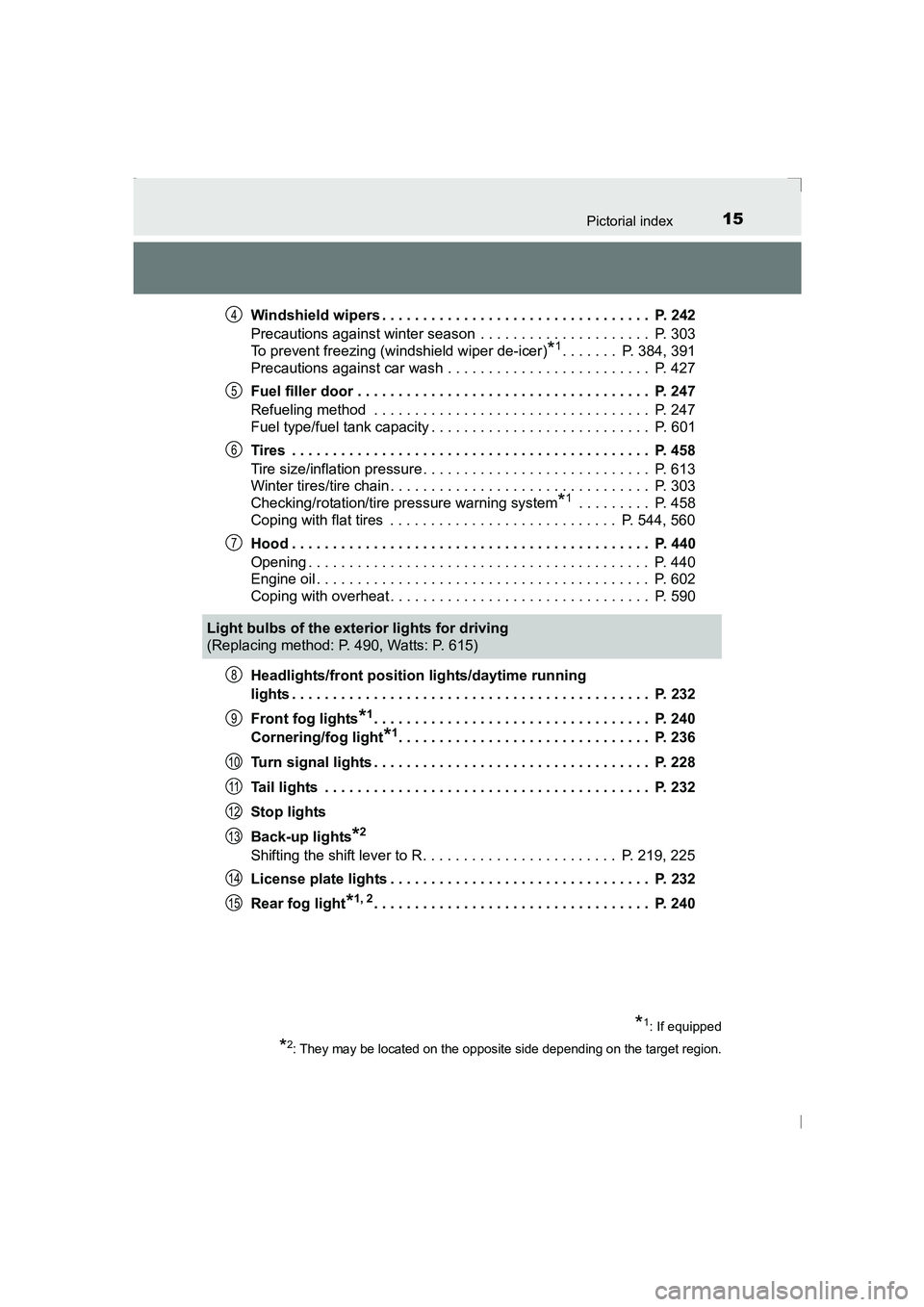
15Pictorial index
AVENSIS_OM_OM20C20E_(EE)Windshield wipers . . . . . . . . . . . . . . . . . . . . . . . . . . . . . . . . . P. 242
Precautions against winter season . . . . . . . . . . . . . . . . . . . . . P. 303
To prevent freezing (windshield wiper de-icer)
*1. . . . . . . P. 384, 391
Precautions against car wash . . . . . . . . . . . . . . . . . . . . . . . . . P. 427
Fuel filler door . . . . . . . . . . . . . . . . . . . . . . . . . . . . . . . . . . . . P. 247
Refueling method . . . . . . . . . . . . . . . . . . . . . . . . . . . . . . . . . . P. 247
Fuel type/fuel tank capacity . . . . . . . . . . . . . . . . . . . . . . . . . . . P. 601
Tires . . . . . . . . . . . . . . . . . . . . . . . . . . . . . . . . . . . . . . . . . . . . P. 458
Tire size/inflation pressure . . . . . . . . . . . . . . . . . . . . . . . . . . . . P. 613
Winter tires/tire chain . . . . . . . . . . . . . . . . . . . . . . . . . . . . . . . . P. 303
Checking/rotation/tire pressure warning system
*1 . . . . . . . . . P. 458
Coping with flat tires . . . . . . . . . . . . . . . . . . . . . . . . . . . . P. 544, 560
Hood . . . . . . . . . . . . . . . . . . . . . . . . . . . . . . . . . . . . . . . . . . . . P. 440
Opening . . . . . . . . . . . . . . . . . . . . . . . . . . . . . . . . . . . . . . . . . . P. 440
Engine oil . . . . . . . . . . . . . . . . . . . . . . . . . . . . . . . . . . . . . . . . . P. 602
Coping with overheat . . . . . . . . . . . . . . . . . . . . . . . . . . . . . . . . P. 590
Headlights/front position lights/daytime running
lights . . . . . . . . . . . . . . . . . . . . . . . . . . . . . . . . . . . . . . . . . . . . P. 232
Front fog lights
*1. . . . . . . . . . . . . . . . . . . . . . . . . . . . . . . . . . P. 240
Cornering/fog light
*1. . . . . . . . . . . . . . . . . . . . . . . . . . . . . . . P. 236
Turn signal lights . . . . . . . . . . . . . . . . . . . . . . . . . . . . . . . . . . P. 228
Tail lights . . . . . . . . . . . . . . . . . . . . . . . . . . . . . . . . . . . . . . . . P. 232
Stop lights
Back-up lights
*2
Shifting the shift lever to R. . . . . . . . . . . . . . . . . . . . . . . . P. 219, 225
License plate lights . . . . . . . . . . . . . . . . . . . . . . . . . . . . . . . . P. 232
Rear fog light
*1, 2. . . . . . . . . . . . . . . . . . . . . . . . . . . . . . . . . . P. 240
4
5
6
7
Light bulbs of the exterior lights for driving
(Replacing method: P. 490, Watts: P. 615)
*1: If equipped
*2: They may be located on the opposite side depending on the target region.
8
9
10
11
12
13
14
15
AVENSIS_OM_OM20C20E_(EE).book Page 15 Thursday, January 29, 2 015 1:47 PM
Page 107 of 648
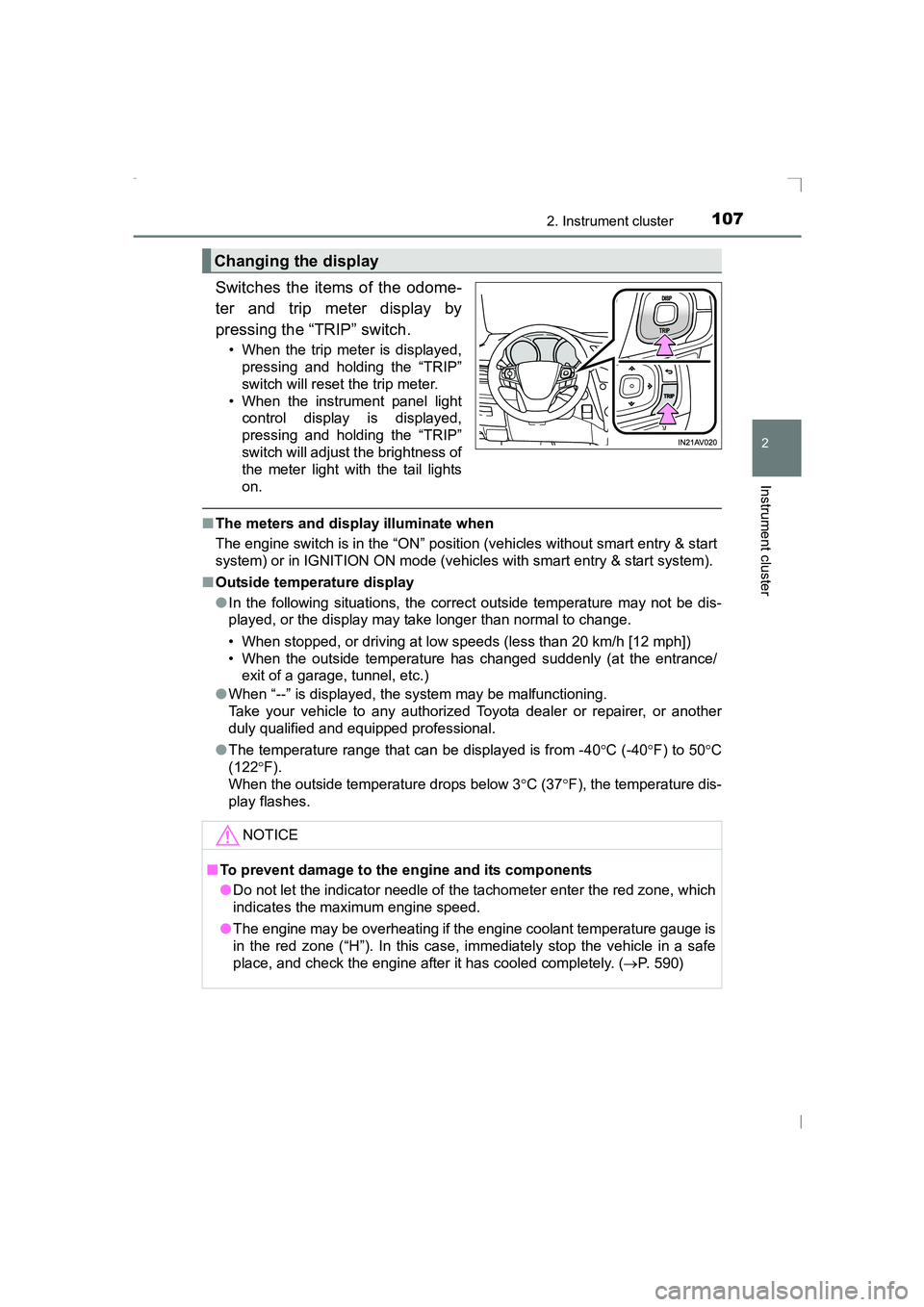
1072. Instrument cluster
2
Instrument cluster
AVENSIS_OM_OM20C20E_(EE)
Switches the items of the odome-
ter and trip meter display by
pressing the “TRIP” switch.
• When the trip meter is displayed,pressing and holding the “TRIP”
switch will reset the trip meter.
• When the instrument panel light control display is displayed,
pressing and holding the “TRIP”
switch will adjust the brightness of
the meter light with the tail lights
on.
■The meters and display illuminate when
The engine switch is in the “ON” position (vehicles without smart entry & start
system) or in IGNITION ON mode (vehicles with smart entry & start system).
■ Outside temperature display
●In the following situations, the correct outside temperature may not be dis-
played, or the display may take longer than normal to change.
• When stopped, or driving at low speeds (less than 20 km/h [12 mph])
• When the outside temperature has changed suddenly (at the entrance/
exit of a garage, tunnel, etc.)
● When “--” is displayed, the system may be malfunctioning.
Take your vehicle to any authorized Toyota dealer or repairer, or another
duly qualified and equipped professional.
● The temperature range that can be displayed is from -40 °C (-40 °F) to 50 °C
(122 °F).
When the outside temperature drops below 3 °C (37 °F), the temperature dis-
play flashes.
Changing the display
NOTICE
■ To prevent damage to the engine and its components
●Do not let the indicator needle of the tachometer enter the red zone, which
indicates the maximum engine speed.
● The engine may be overheating if the engine coolant temperature gauge is
in the red zone (“H”). In this case, immediately stop the vehicle in a safe
place, and check the engine after it has cooled completely. ( →P. 590)
AVENSIS_OM_OM20C20E_(EE).book Page 107 Thursday, January 29, 2015 1:47 PM
Page 191 of 648
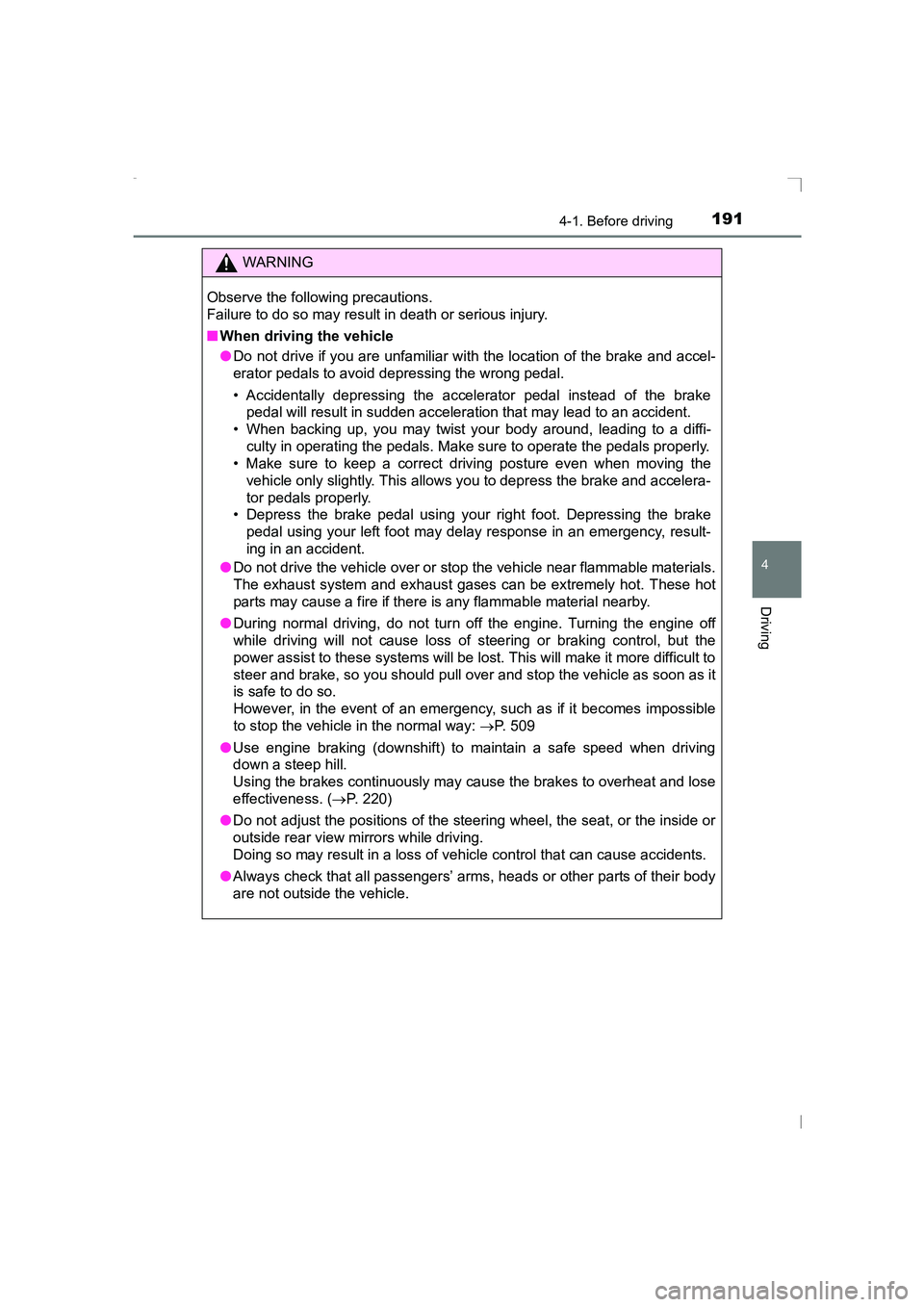
1914-1. Before driving
4
Driving
AVENSIS_OM_OM20C20E_(EE)
WARNING
Observe the following precautions.
Failure to do so may result in death or serious injury.
■ When driving the vehicle
●Do not drive if you are unfamiliar with the location of the brake and accel-
erator pedals to avoid depressing the wrong pedal.
• Accidentally depressing the accelerator pedal instead of the brake
pedal will result in sudden acceleration that may lead to an accident.
• When backing up, you may twist your body around, leading to a diffi- culty in operating the pedals. Make sure to operate the pedals properly.
• Make sure to keep a correct driving posture even when moving the
vehicle only slightly. This allows you to depress the brake and accelera-
tor pedals properly.
• Depress the brake pedal using your right foot. Depressing the brake
pedal using your left foot may delay response in an emergency, result-
ing in an accident.
● Do not drive the vehicle over or st op the vehicle near flammable materials.
The exhaust system and exhaust gases can be extremely hot. These hot
parts may cause a fire if there is any flammable material nearby.
● During normal driving, do not turn off the engine. Turning the engine off
while driving will not cause loss of steering or braking control, but the
power assist to these systems will be lost. This will make it more difficult to
steer and brake, so you should pull over and stop the vehicle as soon as it
is safe to do so.
However, in the event of an emergency, such as if it becomes impossible
to stop the vehicle in the normal way: →P. 509
● Use engine braking (downshift) to maintain a safe speed when driving
down a steep hill.
Using the brakes continuously may cause the brakes to overheat and lose
effectiveness. ( →P. 220)
● Do not adjust the positions of the steering wheel, the seat, or the inside or
outside rear view mirrors while driving.
Doing so may result in a loss of vehicle control that can cause accidents.
● Always check that all passengers’ arms, heads or other parts of their body
are not outside the vehicle.
AVENSIS_OM_OM20C20E_(EE).book Page 191 Thursday, January 29, 2015 1:47 PM
Page 193 of 648
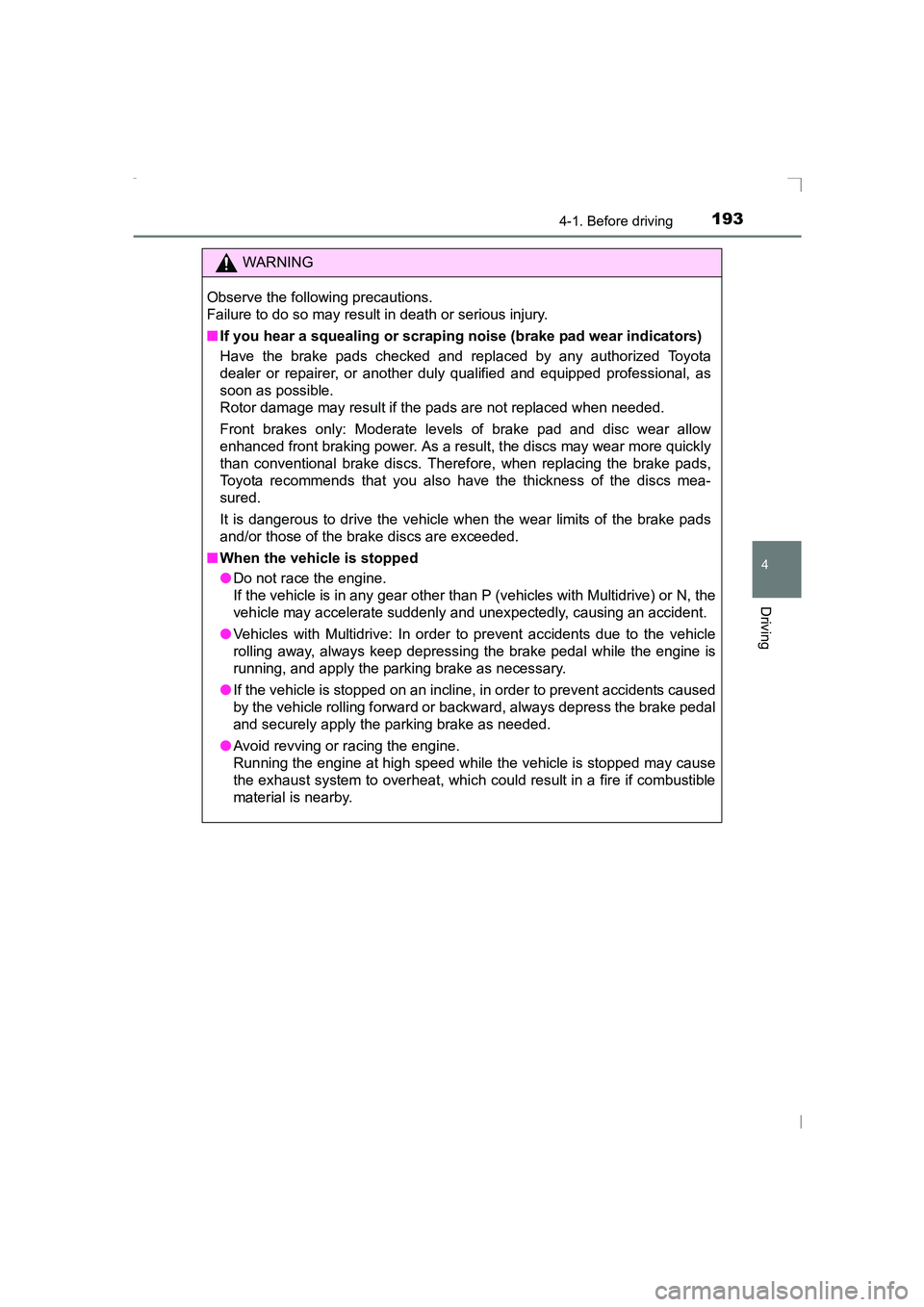
1934-1. Before driving
4
Driving
AVENSIS_OM_OM20C20E_(EE)
WARNING
Observe the following precautions.
Failure to do so may result in death or serious injury.
■ If you hear a squealing or scrapi ng noise (brake pad wear indicators)
Have the brake pads checked and replaced by any authorized Toyota
dealer or repairer, or another dul y qualified and equipped professional, as
soon as possible.
Rotor damage may result if the pads are not replaced when needed.
Front brakes only: Moderate levels of brake pad and disc wear allow
enhanced front braking power. As a result, the discs may wear more quickly
than conventional brake discs. Theref ore, when replacing the brake pads,
Toyota recommends that you also have the thickness of the discs mea-
sured.
It is dangerous to drive the vehicle when the wear limits of the brake pads
and/or those of the brake discs are exceeded.
■ When the vehicle is stopped
●Do not race the engine.
If the vehicle is in any gear other than P (vehicles with Multidrive) or N, the
vehicle may accelerate suddenly and unexpectedly, causing an accident.
● Vehicles with Multidrive: In order to prevent accidents due to the vehicle
rolling away, always keep depressing the brake pedal while the engine is
running, and apply the parking brake as necessary.
● If the vehicle is stopped on an incline, in order to prevent accidents caused
by the vehicle rolling forward or backward, always depress the brake pedal
and securely apply the parking brake as needed.
● Avoid revving or racing the engine.
Running the engine at high speed while the vehicle is stopped may cause
the exhaust system to overheat, which could result in a fire if combustible
material is nearby.
AVENSIS_OM_OM20C20E_(EE).book Page 193 Thursday, January 29, 2015 1:47 PM
Page 195 of 648
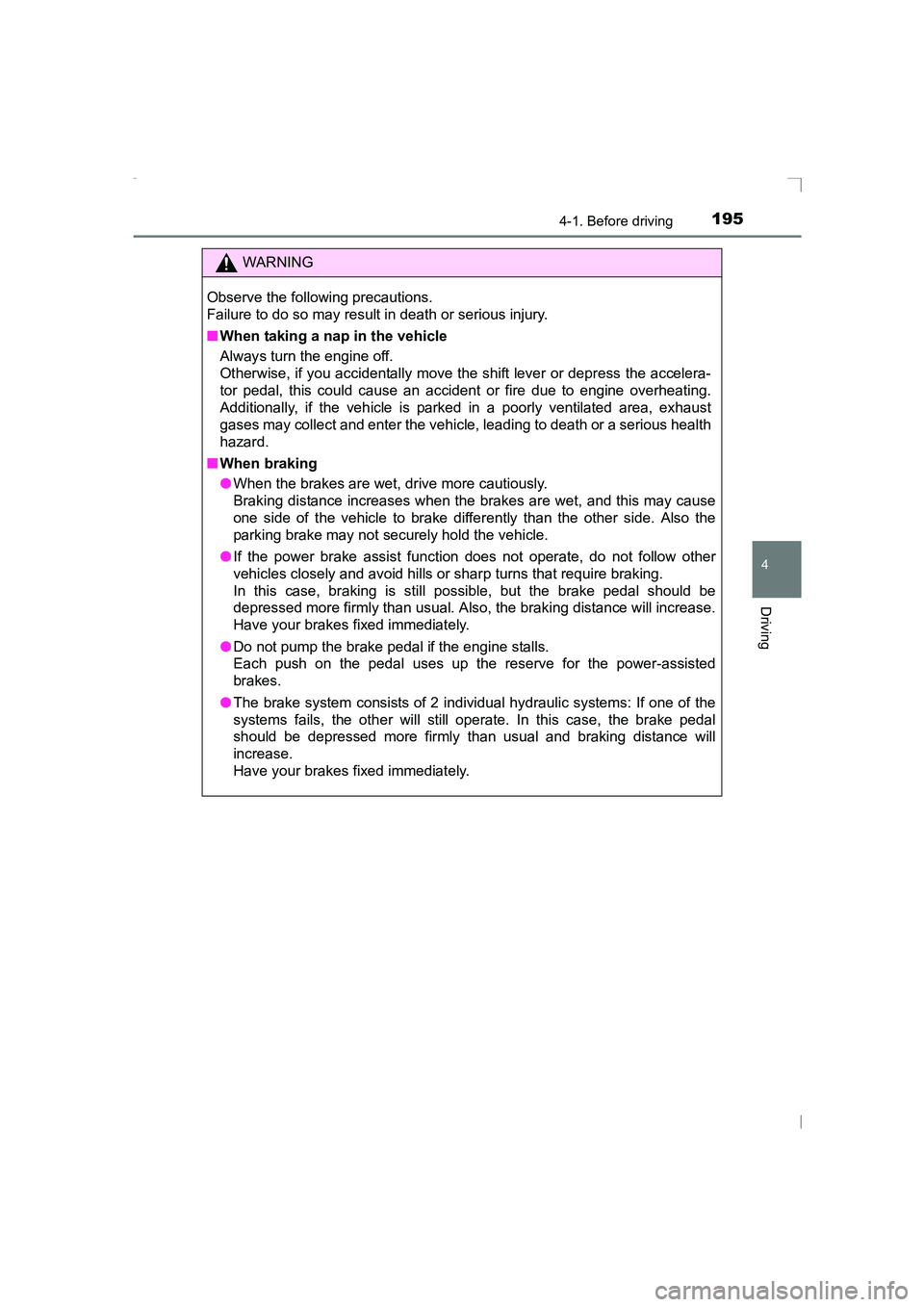
1954-1. Before driving
4
Driving
AVENSIS_OM_OM20C20E_(EE)
WARNING
Observe the following precautions.
Failure to do so may result in death or serious injury.
■ When taking a nap in the vehicle
Always turn the engine off.
Otherwise, if you accidentally move the shift lever or depress the accelera-
tor pedal, this could cause an accident or fire due to engine overheating.
Additionally, if the vehicle is parked in a poorly ventilated area, exhaust
gases may collect and enter the vehicle, leading to death or a serious health
hazard.
■ When braking
●When the brakes are wet, drive more cautiously.
Braking distance increases when the brakes are wet, and this may cause
one side of the vehicle to brake differently than the other side. Also the
parking brake may not securely hold the vehicle.
● If the power brake assist function does not operate, do not follow other
vehicles closely and avoid hills or sharp turns that require braking.
In this case, braking is still possible, but the brake pedal should be
depressed more firmly than usual. Also, the braking distance will increase.
Have your brakes fixed immediately.
● Do not pump the brake pedal if the engine stalls.
Each push on the pedal uses up the reserve for the power-assisted
brakes.
● The brake system consists of 2 individual hydraulic systems: If one of the
systems fails, the other will still operate. In this case, the brake pedal
should be depressed more firmly than usual and braking distance will
increase.
Have your brakes fixed immediately.
AVENSIS_OM_OM20C20E_(EE).book Page 195 Thursday, January 29, 2015 1:47 PM
Page 207 of 648
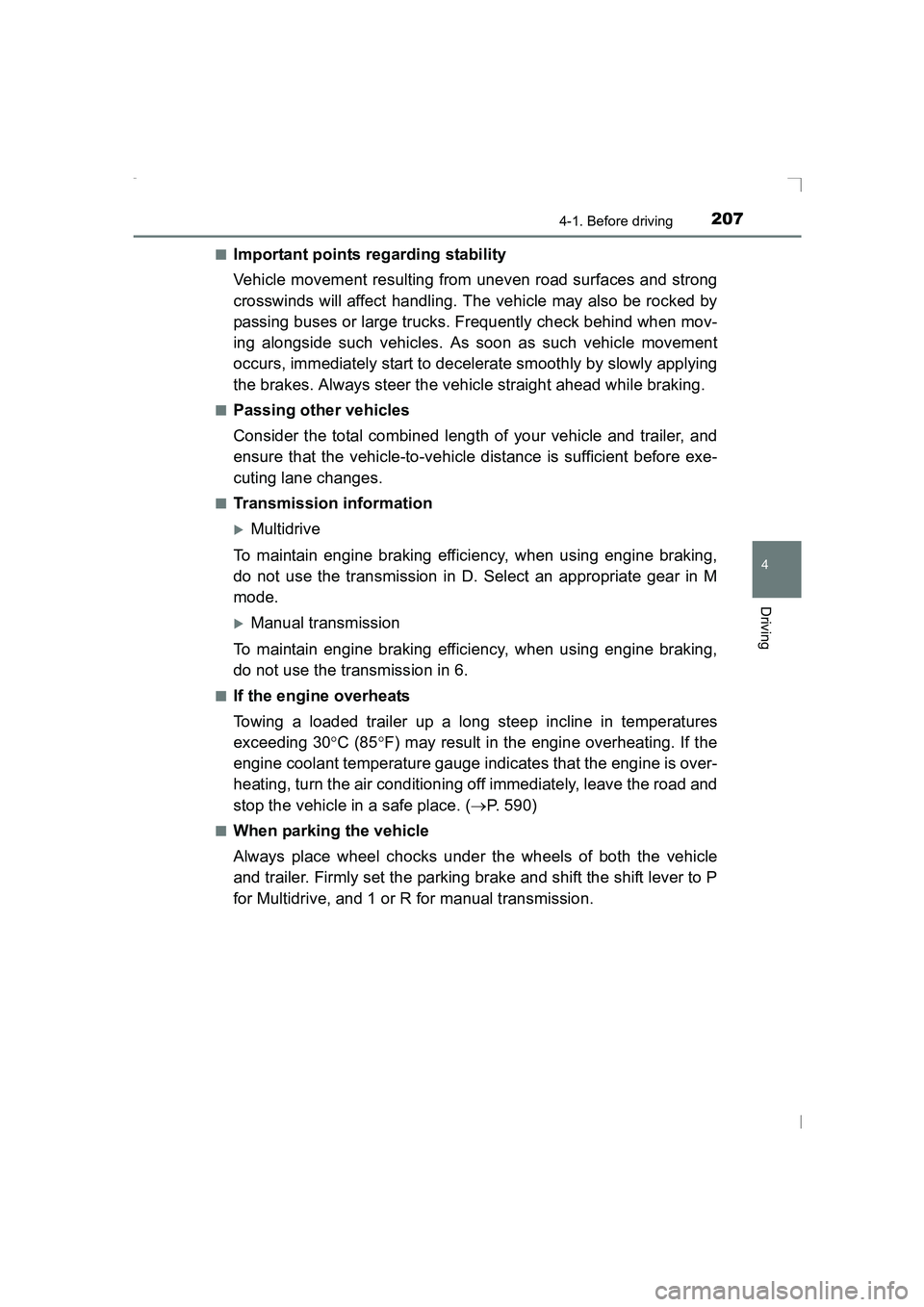
2074-1. Before driving
4
Driving
AVENSIS_OM_OM20C20E_(EE)■
Important points regarding stability
Vehicle movement resulting from uneven road surfaces and strong
crosswinds will affect handling. The vehicle may also be rocked by
passing buses or large trucks. Frequently check behind when mov-
ing alongside such vehicles. As soon as such vehicle movement
occurs, immediately start to decelerate smoothly by slowly applying
the brakes. Always steer the vehicle straight ahead while braking.
■Passing other vehicles
Consider the total combined length of your vehicle and trailer, and
ensure that the vehicle-to-vehicle distance is sufficient before exe-
cuting lane changes.
■Transmission information
�XMultidrive
To maintain engine braking efficiency, when using engine braking,
do not use the transmission in D. Select an appropriate gear in M
mode.
�XManual transmission
To maintain engine braking efficiency, when using engine braking,
do not use the transmission in 6.
■If the engine overheats
Towing a loaded trailer up a long steep incline in temperatures
exceeding 30 °C (85 °F) may result in the engine overheating. If the
engine coolant temperature gauge indicates that the engine is over-
heating, turn the air conditioning off immediately, leave the road and
stop the vehicle in a safe place. ( →P. 590)
■When parking the vehicle
Always place wheel chocks under the wheels of both the vehicle
and trailer. Firmly set the parking brake and shift the shift lever to P
for Multidrive, and 1 or R for manual transmission.
AVENSIS_OM_OM20C20E_(EE).book Page 207 Thursday, January 29, 2015 1:47 PM
Page 211 of 648
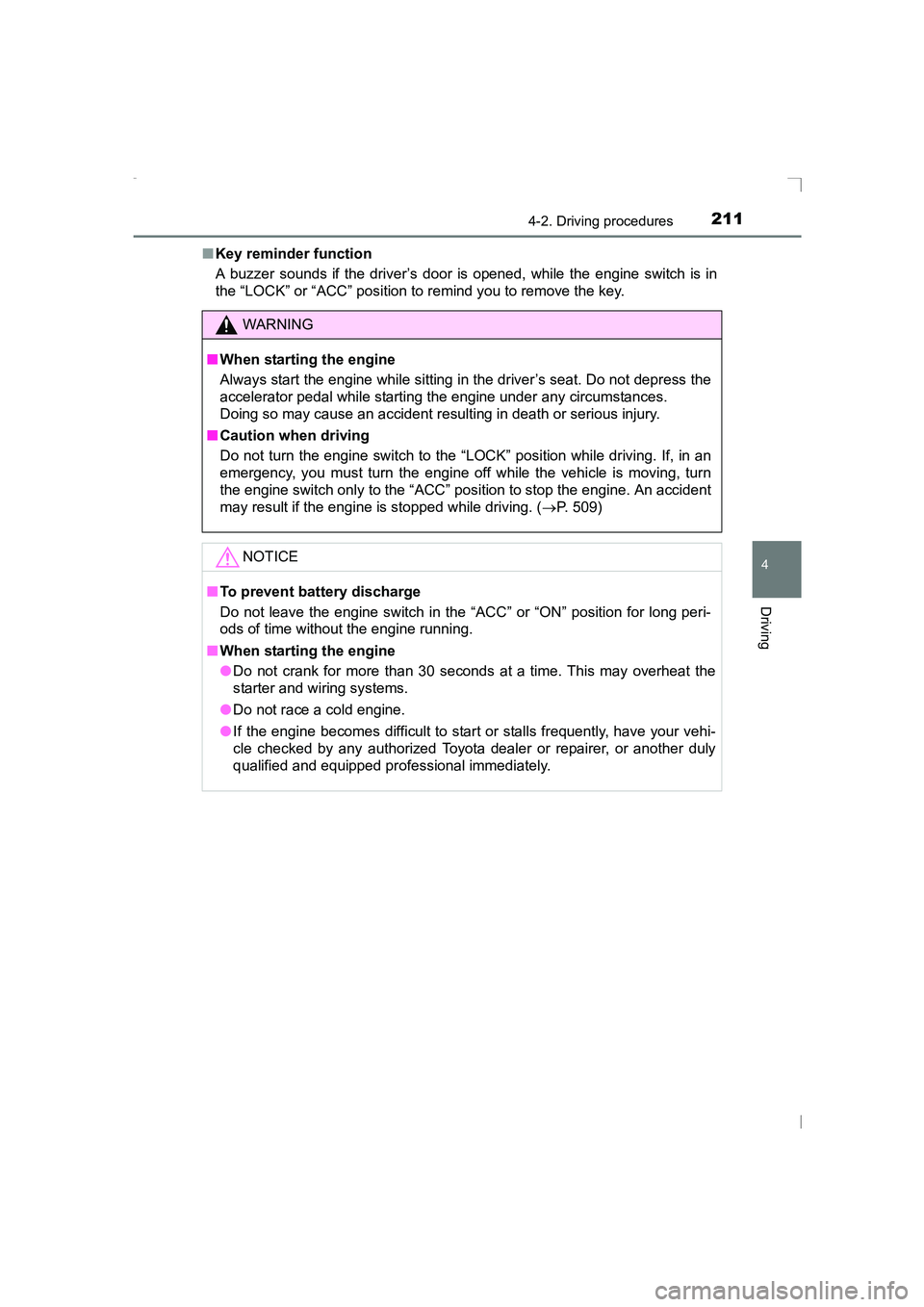
2114-2. Driving procedures
4
Driving
AVENSIS_OM_OM20C20E_(EE)■
Key reminder function
A buzzer sounds if the driver’s door is opened, while the engine switch is in
the “LOCK” or “ACC” position to remind you to remove the key.
WARNING
■ When starting the engine
Always start the engine while sitting in the driver’s seat. Do not depress the
accelerator pedal while starting the engine under any circumstances.
Doing so may cause an accident resulting in death or serious injury.
■ Caution when driving
Do not turn the engine switch to the “LOCK” position while driving. If, in an
emergency, you must turn the engine off while the vehicle is moving, turn
the engine switch only to the “ACC” position to stop the engine. An accident
may result if the engine is stopped while driving. ( →P. 509)
NOTICE
■ To prevent battery discharge
Do not leave the engine switch in the “ACC” or “ON” position for long peri-
ods of time without the engine running.
■ When starting the engine
●Do not crank for more than 30 seconds at a time. This may overheat the
starter and wiring systems.
● Do not race a cold engine.
● If the engine becomes difficult to start or stalls frequently, have your vehi-
cle checked by any authorized Toyota dealer or repairer, or another duly
qualified and equipped professional immediately.
AVENSIS_OM_OM20C20E_(EE).book Page 211 Thursday, January 29, 2015 1:47 PM
Page 217 of 648
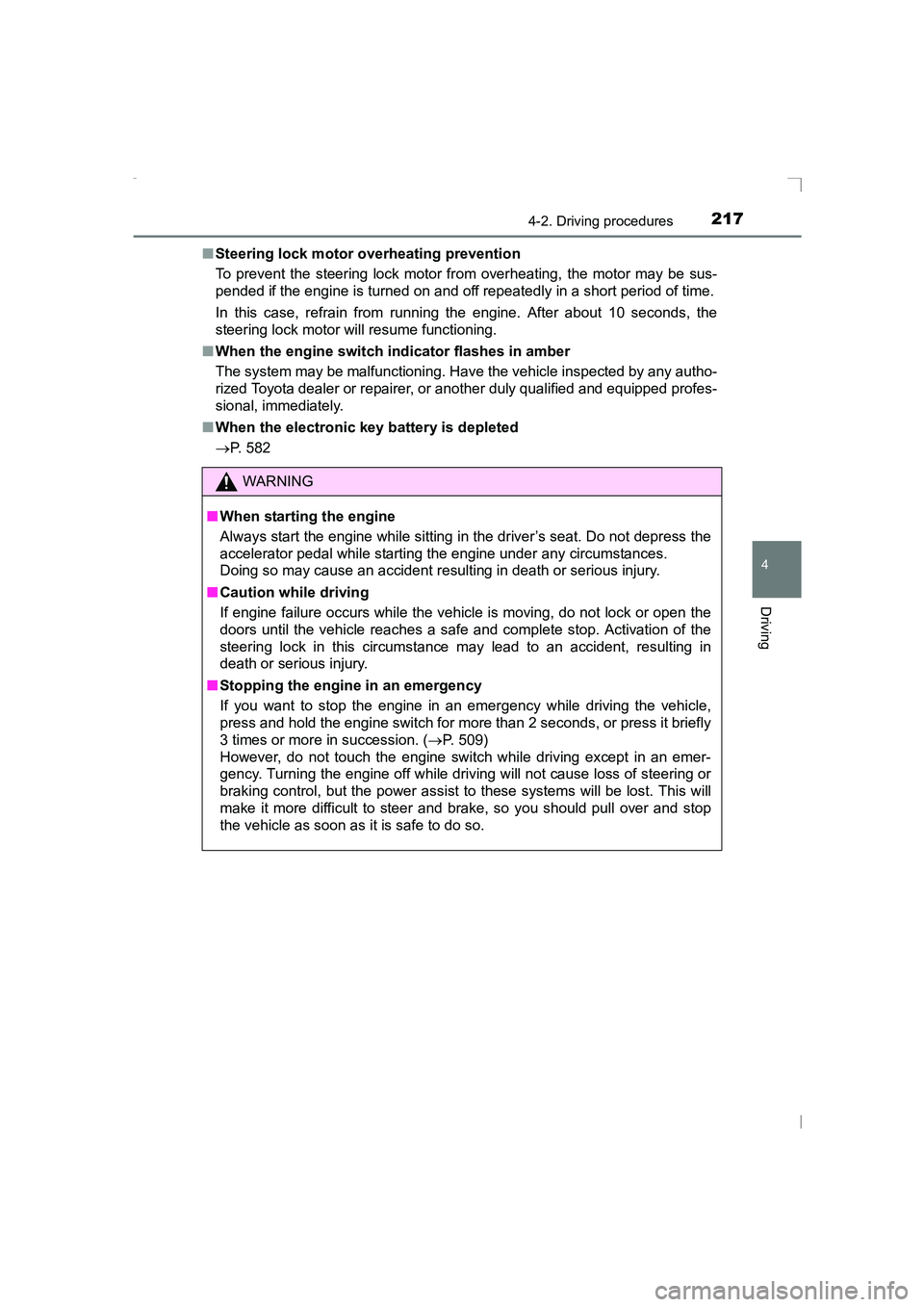
2174-2. Driving procedures
4
Driving
AVENSIS_OM_OM20C20E_(EE)■
Steering lock motor overheating prevention
To prevent the steering lock motor from overheating, the motor may be sus-
pended if the engine is turned on and off repeatedly in a short period of time.
In this case, refrain from running the engine. After about 10 seconds, the
steering lock motor will resume functioning.
■ When the engine switch in dicator flashes in amber
The system may be malfunctioning. Have the vehicle inspected by any autho-
rized Toyota dealer or repairer, or another duly qualified and equipped profes-
sional, immediately.
■ When the electronic key battery is depleted
→ P. 582
WARNING
■ When starting the engine
Always start the engine while sitting in the driver’s seat. Do not depress the
accelerator pedal while starting the engine under any circumstances.
Doing so may cause an accident resulting in death or serious injury.
■ Caution while driving
If engine failure occurs while the vehicle is moving, do not lock or open the
doors until the vehicle reaches a safe and complete stop. Activation of the
steering lock in this circumstance may lead to an accident, resulting in
death or serious injury.
■ Stopping the engine in an emergency
If you want to stop the engine in an emergency while driving the vehicle,
press and hold the engine switch for more than 2 seconds, or press it briefly
3 times or more in succession. ( →P. 509)
However, do not touch the engine switch while driving except in an emer-
gency. Turning the engine off while driving will not cause loss of steering or
braking control, but the power assist to these systems will be lost. This will
make it more difficult to steer and brake, so you should pull over and stop
the vehicle as soon as it is safe to do so.
AVENSIS_OM_OM20C20E_(EE).book Page 217 Thursday, January 29, 2015 1:47 PM